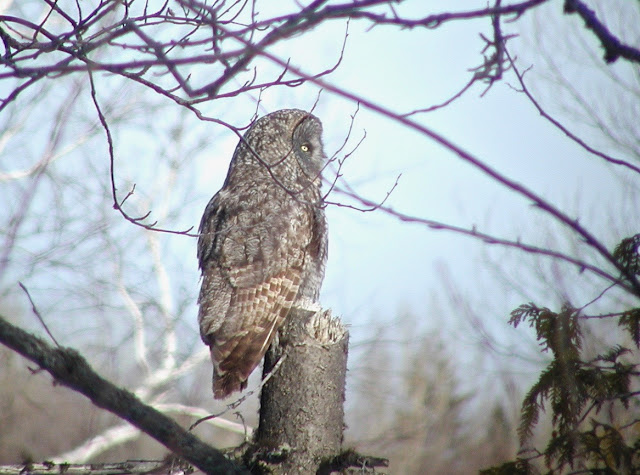Great Gray Owl - Our Largest and Rarest Owl
 |
| Great Gray Owl |
The Great Gray Owl (Strix nebulosa) is our largest and rarest owl species. It is only seen in New Brunswick rarely and always in winter. The range of this northern owl is from Alaska across the northern parts of the prairie provinces to northern Ontario. Its range extends south of the Canada/US border in the Rocky Mountains. During winters occasionally some individuals move south of the range to spend the winter months in the southern prairie provinces, south of the Great Lakes and into New England, southern Quebec and the Maritime Provinces. Usually this southern movement brings a few individuals into the southern areas but in some years when northern food sources are scarce, irruptions will occur.
 |
| Great Gray Owl |
In former times this species was listed as a 'casual winter resident' of New Brunswick. I don't think that would be accurate now. We have had very few reports over recent years. The photos shown in this post were taken by me from a winter visitor to the Cambellton area in March, 2005. We have had other sightings over the past 25 years. In 1996 one was seen by many at Hopewell Cape. There was another at Bushville that year. A few specimens were taken in the early 1900s, one from Fredericton in March, 1906, others from 1862 and 1903. A notable incursion occurred in 1978-1979 to a small island near Kingston, Ontario (Amherst Island). Thirty-four individuals were counted on that island at that time. During another irruption (in 2004-2005), 1700 individuals were recorded in northern Minnesota.
 |
| Great Gray Owl |
The Great Gray Owl is our largest owl by length (but not by weight). The Snowy Owl is our largest owl by weight. The Great Gray Owl is 69 cm/27 inches long with a very wide wingspan (140 cm/55 in). When perched it looks very 'fluffed up', which is probably a strategy to keep warm as it perches for long periods on tree stubs or fence posts watching for prey. It eats mainly small rodents and other mammals. Its keen eyesight and hearing can spot prey even when it is under the snow. It can take its prey by plunge-diving either feet- or head-first. Its flight is described as heron-like with long slow wing beats.
 |
| Great Gray Owl |
The Great Gray Owl is mainly gray with brown markings. Its head appears disproportionately large. It is hornless with very large facial discs. The eyes are yellow and the tail is long. The only other owl one might mistake it for is the Barred Owl which is smaller, mainly brown, and has dark eyes. The large facial discs of the Great Gray show five concentric rings. These make the eyes appear small. There is a black-and-white bowtie marking below the mouth which is not always visible. Sibley's The Sibley Guide to Birds shows this bowtie well on page 273.
Great Gray Owls nest in abandoned hawk or crow nests in either coniferous or deciduous trees. Two to five dull white eggs are laid and incubated for 28-29 days by the female. The adults are fierce around their nests. They have been known to drive off predators as large as bears. The courtship call of this species is heard only at night even though this is a diurnal owl. The male makes a muffled deep whoo sound which is repeated 5-10 times. The female answers with a whoop sound.
The Great Gray Owl is a holarctic species, breeding also in Europe and Asia. It was first described as a species in 1772 by Johann Reinhold Forster. It has been known by many names over the years and over its large geographical range. It has been called Phantom of the North, Spectral Owl, Lapland Owl, Spruce Owl, Bearded Owl and Sooty Owl. That indicates it has had a long history of interactions with humans!
No comments:
Post a Comment